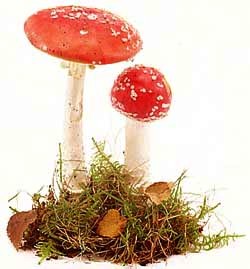DK Nature: Fungi
Neither plants nor animals, the fungi kingdom includes toadstools, puffballs, and MOLDS. Fungi feed on living or dead organisms by making them rot. Fungi are visible only when spore-bearing fruiting bodies form.
Fungi absorb nutrients from plant or animal matter around them, which may be living or dead. They produce long, slender threads called hyphae that spread through their food. The hyphae release enzymes that break down the food into substances that the fungi can easily absorb.
Most fungi reproduce by releasing tiny spores that then germinate (sprout) and grow into a new fungus. The spores are produced by, and released from, a fruiting body that is visible above the ground. Some fungi drop spores, which are blown away by the wind. Others shoot them out in an explosive burst.
Toadstools are brightly colored and poisonous to eat, but mushrooms are usually edible and dull in color. Both toadstools and mushrooms are fruiting bodies (spore-bearing structures) produced by fungi. They belong to the same group, the Basidiomycetes, so scientists make no distinction between the two.
Scientists are continually revising the classification of the fungi kingdom (with more than 100,000 species), but currently they divide it into three groups:
| Pin molds (Zygomycota); |
| Yeasts, molds, morels, and truffles (Ascomycota, or spore-shooters); |
| Smuts, rusts, jellies, mushrooms, and brackets (Basidiomycota, or spore-droppers). |
Fungi called molds produce the woolly or furry growths found on rotting foods, such as bread and fruit. The growths are formed by threadlike hyphae that grow upward and release spores from their tips. These spores then sprout on other foods.


